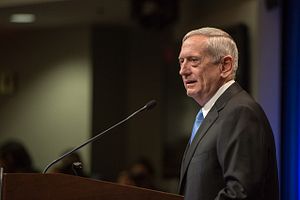New U.S. Secretary of Defense James Mattis visited East Asia for his first foreign trip as the head of the Pentagon. Over the last several days, he visited the Republic of Korea (ROK) and Japan, meeting with his counterparts in both countries.
Mattis’ visit to the region, amid reports that North Korea has re-started its nuclear reactor, has been characterized as a way to provide reassurance to Tokyo and Seoul. That is precisely what the two countries are expecting from his visit.
During the presidential campaign, then-candidate Donald J. Trump made often made headlines seemingly questioning the value of U.S. alliances. He hinted that his administration might threaten to pull out U.S. forward-deployed forces if allies do not bear the full cost of stationing U.S. troops in those countries. His frequent references to NATO being “obsolete” also stirred concerns in Tokyo and Seoul that he may look at U.S. alliances in Asia in a similar light.
Japan and the ROK, along with other U.S. allies and partners around in the world, have been desperately seeking signs of reassurance ever since the transition to the Trump administration began in November 2016. Therefore, there was a great sense of relief felt in both capitals when Mattis, a retired general, was nominated to be the secretary of defense. The importance he placed on maintaining robust U.S. alliances and partnerships around the world in his confirmation hearing was also reassuring. Deputy Secretary Robert Work staying in position — one of very few holdovers among the Obama administration’s political appointees — for the time being also signaled to allies that they will see fewer surprised coming out of the Pentagon compared to other federal agencies.
Mattis’ visits were warmly received in both South Korea and Japan. He has a solid reputation as a charismatic, thoughtful leader, with a very personable way of engaging people in conversations. The central message he carried to key allies in Northeast Asia — that the United States will continue to uphold its commitment under the alliance — surely gave his counterparts in Seoul and Tokyo a sense of reassurance about U.S. commitments in the Asia-Pacific region.
Indeed, U.S. alliances in Asia are one of the few areas in which one sees some degree of continuity under the new administration. Despite his comments during the campaign, President Trump no longer openly talks about demanding U.S. allies in Asia “pay up” for the cost of stationing U.S. troops. The first foreign leader he met after the election was Japanese Prime Minister Shinzo Abe, who will return to Washington on February 10. In his telephone conversation with South Korea’s Acting President Hwang Kyo-Ahn on January 29, Trump reiterated the United States’ “ironclad” commitment to defend the ROK. Mattis’ visit to U.S. two key allies in Asia can be a signal that the new administration, despite its campaign rhetoric, takes security challenges in the region seriously and is willing to let Mattis take the lead in managing key alliances and partnerships in this part of the world.
In fact, the real challenges for Mattis during his first months as the secretary of defense may be at home. On January 27, as Mattis prepared to leave for his Asia trip, Trump signed a sweeping executive order that imposes a temporary ban on U.S. entry for the citizens of seven countries whose populations are predominantly Muslim. The order also put in place a temporary freeze on accepting refugees. Although the White House explained that these measures are temporary and not meant to target Muslims, it has been pointed out by many, including Senator John McCain and Lindsay Graham, that this measure runs against U.S. efforts to work with local military and security forces in these countries, where the DOD plays a key role. Predominantly Muslim partners in the Asia-Pacific, including Indonesia and Malaysia, will likely want explanations that their own citizens won’t be impacted by additional orders in the future.
Another executive order on January 29 added Trump’s chief strategist, Steve Bannon, as a permanent member to the “Principals Committee” in the National Security Council and, at the same time, essentially limits attendance by the director of national intelligence (DNI) and chairman of the Joint Chief of Staff (CJCS) by including them “as invited.” Mattis will not only have to represent the position of Department of Defense, but also have to ensure that input from the CJCS, as the principal military adviser to the secretary of defense and the president, is reflected in the meeting when the CJCS is not invited to the meetings.
In his confirmation testimony, Mattis described the global security environment as “a world awash in change.” He explained: “[O]ur country is still at war in Afghanistan and our troops are fighting against ISIS and other terrorist groups in the Middle East and elsewhere. Russia is raising grave concerns on several fronts and China is shredding trust along its periphery. Increasingly, we see islands of stability in our hemisphere, in Europe, and in Asia under attack by non-state actors and nations that mistakenly see their security in the insecurity of others.” With multifaceted challenges abroad and political division and turmoil at home, his Asia trip — along with the phone conversations he has had with European and other allies since taking office — suggests that Mattis will have a very full plate in his new responsibility as the top civilian in the Pentagon.

































